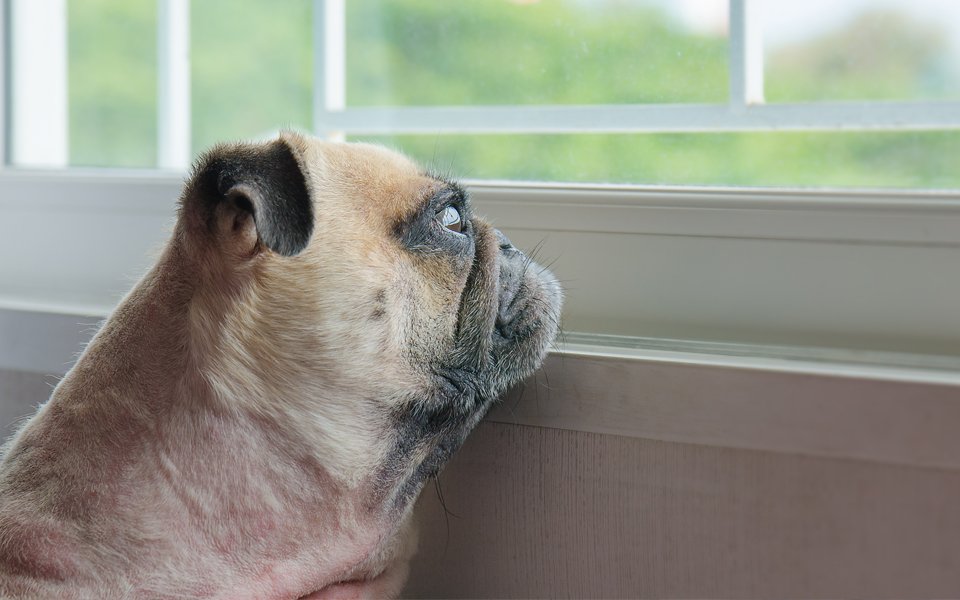
How to Help Your Dog with Post-Quarantine Anxiety
Did you spend a significant amount of time at home this past year? You’re not alone. Did you eagerly seek out a new furry companion in the form of a puppy or a rescue? You’re not alone there either. Are you experiencing some symptoms of dog anxiety...?
According to the American Pet Products Association, about 12.5 million U.S. households acquired a new pet last year after the pandemic was officially declared.
But as many folks are returning to their more “normal” lives, some are finding that their new adoptions aren’t working out as well as they’d hoped or expected.
While many rescues were seeing double the number of adoptions in 2020, they are now seeing just the opposite with an increased number of surrenders in 2021.
What’s the most common cause of dogs being surrendered? A change in schedule is definitely a big one, but according to the ASPCA, pet behavior is a leading cause. With millions of pups having limited training and limited social and environmental exposure due to quarantine and social distancing, it’s easy to see why there are now a lot of stressed pups (and stressed pup parents).
In this article, we’ll cover separation and fear-based dog anxieties, which are both being seen more commonly in the post-quarantine era. We’ll also discuss some therapeutic approaches to help a stressed and fearful pup, as well as the best time to see your vet to have an in depth conversation about treatment options.
Have a Dog with Separation Anxiety?
Coming home to a busted, bent up crate, chewed blankets, a house that looks like it was hit by a tornado, or a voicemail from your neighbor complaining about incessant barking and howling coming from your home? If so, your pup might be suffering from the most common singular form of anxiety, separation anxiety.
Separation anxiety in dogs stems from fear of being alone. Most often, we see this first present gradually in a growing puppy, or it might be perceived to occur “suddenly” in a newly adopted pooch. Recently, separation anxiety is becoming more common in dogs adopted during the pandemic who were used to spending most of their time in the same limited environment and with the same small number of people who are now leaving the home more.
Separation anxiety in dogs can take many forms, but often presents as destructive behavior. We can also see pups poop and pee in the house, and noise complaints from neighbors because of a dog’s excessive barking and howling all day long when his human companions are not home.
Is Your Dog Afraid of Certain Things?
All of us are afraid of at least one thing, and the same can go for our pets. There are lots of sights, sounds, and smells that can trigger a dog’s personal concerns about safety and security.
I have encountered some interesting fear triggers, including fear of running water, people who wear hats, stairs, and most recently, of a door opening (and closing).
Especially in young dogs, fear can develop to something or someone unfamiliar that a pup had no exposure to. This has become a big problem in the post-COVID quarantine era, as many dogs who spent a majority of time at home are now being introduced to unfamiliar environments, people, and other pets. We can see dogs bark, growl, or otherwise act defensively when thrust into new social situations.
The first key to tackling fear is identifying and understanding the trigger. Once we’ve done that, then we can enact some therapeutic measures that we’ll get to in just a minute.
Is Your Dog Afraid of Everything?
No dog can literally be afraid of everything, but it can certainly seem that way with some dogs that have more of a generalized anxiety.
Generalized anxiety involves multiple triggers. Typically so many that it’s hard to make out any situations where a dog is not anxious or fearful. This is similar to generalized anxiety disorder (GAD) seen in humans.
According to a 2009 Compendium article on the topic, veterinary behaviorist Dr. Sharon Crowell-Davis indicates that pets may exhibit signs very similar to humans with GAD, showing constant signs of fear and anxiety regardless of the situation or exposure.
Dr. Crowell-Davis mentions that many newly adopted pets can exhibit some signs of low-level anxiety when entering a new home but if a period of 2-3 months passes and the pet’s anxieties persist, a generalized anxiety disorder can be presumed.
What Can We Do to Help an Anxious or Fearful Dog?
So what types of things can we do at home to help stressed and fearful pups?
Behavior Modification
Behavior modification is a core component of addressing any anxiety or fear condition. By modifying a behavior, it can be possible to reduce the need for medical therapy.
There are three types of behavior modification applied in treating fear and anxiety.
Counterconditioning
Counterconditioning is a strategy whereby we aim to change a dog’s emotional response to a particular stimulus. A simple example is when a delivery person comes to the door, and your dog, very anxious about strangers approaching his home, barks incessantly or even growls at the door.
We would look to pair the sight, smell, and sound of an approaching delivery person with a positive reward to alter the dog’s state from fear and anxiety to one that is positive.
It is also crucial to avoid any negative outcomes during counterconditioning training. A simple way to accomplish this is to initiate a command, like “sit” or “stay” to redirect your pup’s focus away from the stimulus. Then, with his attention on you, you can provide treat rewards until the stimulus passes (in other words, the delivery person drops off their package and is walking back to their truck.)
This strategy can also work for newly visiting friends or family. Just keep initial visits shorter. When your pooch is calm and settled, have visitors provide some of the treat rewards.
Desensitization
Desensitization involves gradual exposure to situations or stimuli by finding that threshold below which a pup doesn’t exhibit a fear or anxiety response.
For separation anxiety, this can mean reintroducing a crate or being more diligent about its use. It’s important to make the crate a safe and comfortable place for your pup.
If your dog whines or cries immediately when crated or immediately when you leave, start by keeping the crate open and available when you’re around. Then, use short “quiet time” periods of crating when you’re still home where your pup can work on a toy like a Kong, filled with a treat to keep him preoccupied.
Before departing the home, start with crating your pup for long periods of time before leaving, and gradually decrease this time period. You might start with as long as 30 minutes to an hour while you all get ready to go out. Give her a toy or a treat she can preoccupy herself with.
Then, gradually decrease this time period every couple of days by about 10 minutes each time.
In this way, you’re desensitizing your dog to a fear of association between being crated and you being absent.
Situation Avoidance
Situation avoidance is not always possible, but if it is, this strategy can go a long way towards outright eliminating situational anxiety or fear.
A common example we can use is fear or aggression towards other dogs. While it’s not practical to remove outdoor walks from your dog’s schedule, there are ways to avoid situations that would induce a fear or aggression response towards another dog.
You’d start by completely avoiding dog parks, pet stores, pet-friendly hardware stores, etc. While you can’t avoid other dogs completely on walks outside, you can choose a route that is more open where you can see any other pup/pup parent pairs approaching.
If you do see another dog approaching on a leash with his human companion, take the initiative to cross to the opposite side of the street where they may only be able to see each other at a far distance. You can then employ counterconditioning (or desensitization if you find that no fear/aggression response occurs at a certain distance) until the other dog passes by.
Supplements and Herbs
There are many products in the supplement and herbal categories that can be used to address anxiety. The benefit of considering them first, along with behavior modification, is that there is a very low risk of adverse effects, while they can bolster your efforts with training.
Melatonin is a naturally occurring hormone that helps to regulate the sleep cycle. It can also naturally help with anxiety and stress by promoting a calming and relaxing effect. Many humans take melatonin supplements to help them sleep, or to just relax. .
Passion Flower refers to a large family of flowering vine-like plants native to the southeast United States, and Central and South America. The specific plant Passiflora incarnata is often used as a supplement to help with anxiety and sleep disorders. In 2019, a study published in Functional Foods in Health and Disease found through a randomized, placebo-controlled double-blind trial that a passionflower extract improved several emotional parameters in people, suggesting that it could be useful for improving anxiety.
Chamomile refers to a family of daisy-like flowers. Many folks are familiar with chamomile tea as a home remedy to promote a state of rest and calm. Research published in 2009 in the Journal of Clinical Psychopharmacology found through a randomized, double-blinded, placebo-controlled study that an extract of chamomile proved to have modest benefits in terms of reducing anxious activity in human patients with generalized anxiety disorder (GAD).
Ziziphus, also commonly known as jujube, is a sour date-like fruit that grows in southeast Asia. A 2017 article published in Evidence-Based Complementary and Alternative Medicine discussed its use for over 3000 years in TCM to calm the nerves and reduce irritability, and that in mice, it has been found to promote sedative and anxiety-reducing effects, also helping to improve memory and learning.
Dan Shen refers to the dried root extract of the Chinese plant Salvia miltiorrhiza. A very recent study published this year in the Journal of Ethnopharmacology found that it exerts its sedative and anxiety-reducing effects specifically through the mood-stabilizing serotonin, and through enhancing GABA, the primary inhibitory neurotransmitter in the brain.
Schizandra is a small berry-like fruit that grows on a vine sort of like grapes do. In a study from this year published in Phytotherapy Research, Schizandra chinensis, when combined with another herb called Scutellaria baicalensis had a positive effect on stress responses in mice.
Polygala refers to a family of flowering shrubs that produce attractive, small purple blossoms. Two 2014 articles highlight some of this attractive plant’s benefits. One, in PLoS One, showed that a Polygala tenuifolia extract can have a rapid onset of antidepressant-like effects. The second, in Animal Cells and Systems, found that a similar extract significantly reduced anxiety-like behaviors in mice.
Oyster shell extract is not really an herb, but is an ingredient that has been used in TCM for thousands of years for its sedative properties to help calm the mind, and promote peaceful sleep and relaxation.
When selecting supplements, remember that these are not widely regulated. Speak to your veterinarian first about supplements that may help your stressed pup. Then, make sure to look for products made by National Animal Supplement Council (NASC) member companies, like NaturVet. Supplements produced by NASC member companies have reliably-sourced ingredients and voluntarily follow strict quality-control standards.
When to See Your Vet and Consider Medical Therapy
If starting off with a supplement coupled with basic behavioral modification techniques is not bringing about a desired outcome in reducing a pup’s fear and anxiety, or in cases where a pup’s anxiety is generalized or severe, it’s best to see your vet and consider medications coupled with professional training or behavior therapy.
Prescription medications for treating anxiety act on neurotransmitters in the brain, like serotonin or dopamine, and try to bring them into better balance. Some short-term medications may be indicated for situational anxiety, while others are designed more for long-term therapy. Your vet can discuss with you what medical therapy might be most appropriate, as well as any potential side effects or interactions with other medications.
Your veterinarian is also going to be the best source to provide you with a list of trainers in the area. In-home trainers that incorporate you deeply in your dog’s training are best. In some cases, your veterinarian may refer you to a board-certified veterinary behaviorist who is a veterinarian specializing in behavior.
They’re There for Us, Be There for Them!
Pets have been a big source of comfort for us during the pandemic quarantine. But things are changing once again, causing new sources of stress and dog anxiety for our furry companions.
Managing a fearful or anxious dog can be a big responsibility and working to change these behaviors can take time. If you’re seeing these behaviors develop in your young pup, adoption, or rescue, make sure to reach out to your vet before considering surrendering your pooch back to the shelter or a rescue.
Let’s give back to them as much back as they’ve given to us.
JOIN OUR PACK
Follow us @NaturVet on social media to fill us in on any tips we might have missed. And, check out the rest of NaturVet.com. We’ll keep you up to date on all our latest pet resources, supplements, tips and tricks, and more – everything you need to be the best pet parent possible.









